Case Studies
Ranch Ponds
Twin Oaks Stables
Holly Springs, MS
The lake at the Twin Oak Stables is located on a family ranch in Mississippi. The lake was built about 2 years prior to our involvement in the project and had thus far been unsuccessful. We were privileged to partner with Bill Dance Signature Lakes to develop a strategy to overcome the many obstacles presented with this project.
The native soil was not of sufficient quality for a soil liner. The soil was very sandy and our on-site representative was able to assist in locating better quality soil to replace the sandy areas. The dam, as it was originally designed, was insufficient to support the 35-acre, 25-foot deep lake and was actively leaking. Our on-site representative oversaw the widening and reconstruction of the dam with the inclusion of ESS-13. There was a significant amount of dirt that needed to be moved during this time. Throughout the project, sporadic rain caused delays in progress. The crews were only able to move dirt for a few days at a time between rain episodes. Due to weather constraints and the size of the lake, the liner was built in sections starting from the deepest point, and filled as they went.
Today the lake is full, with water loss reduced mainly to evaporation. The lake has been stocked with bass and a variety of vegetation. There is also a beautiful boathouse/fishing pier located on the lake. Our client is extremely pleased to see their project turned into what they had envisioned many years previously.
Every lake seems to have unique challenges and by involving the expertise of our field representatives, our ESS-13 products, and our construction techniques we are able to overcome these challenges resulting in a successful project.
Housing Developments

Pulte Homes Westlake Development
Stockton, CA
When Pulte Homes was planning their Westlake Subdivision Project in Stockton, California, the decision was made to consider sealing their 54 acre lake using the ESS-13 Spray-On Formulation. Prior to making the final decision, they constructed a small, one acre test pond to assess the product’s performance.
In January 2006, the ESS-13 Spray-On Formulation was applied to the one acre test pond. There were portions of the pond bottom that were quite saturated making it difficult to achieve the required compaction. Within hours of the Spray-On Application being applied and before the product was able to sufficiently dry, the sky opened up and it literally rained for months. The site conditions were less than perfect.
Test equipment was set up nearby in an enclosure to compare the data gathered from sensors in the lake. This data was used to derive a comparative rate of evaporation and water loss. The results of the testing demonstrated that the water loss in the pond was primarily due to evaporation.
In August of 2006, the pond was drained and four holes were dug into the pond bottom. The engineering firm, PACE, took measurements of the saturation in the pond bottom. All four test holes revealed three inches of saturated soil. Underneath the three inches, the soil was bone dry. PACE concluded in their report that the treatment was successful in sealing the lake from water loss due to seepage. PACE went further and recommended that the ESS-13 Spray-On Formulation be used for sealing the large subdivision lake.
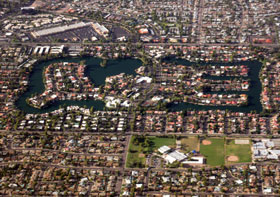
The Lakes Community
Tempe, AZ
This project was completed in 1972
The Association has a total of 50.2 surface acres of lakes. The lakes were sealed by compacting two six-inch layers of chemically treated dirt. Even after 40 years, the bottom and sides are in excellent condition. It is apparent that little if any loss is being experienced through seepage. This can be attributed to the excellent design of the lakes and the work of Seepage Control, Inc.
Outback Resort
Vernon, BC Canada
Three lakes – 119,790 sq ft
The Outback Resort water features consist of three lakes joined by waterfalls. The resort and the lakes are under the supervision of the Stonecroft Management firm of Vancouver BC in Canada. This building project is located in the Okanagan Valley near Vernon BC. The lakes are to sustain trout fishing and water plants.
Stonecroft contacted Seepage Control, Inc. as a result of an internet search. They were inquiring about a small test pond they had constructed that was experiencing some water loss due to seepage. A Seepage Control site supervisor was dispatched to the site to evaluate the pond. After a Waterborne treatment there was a marked reduction in seepage. Stonecroft was so pleased with the result they requested that the three lake project would benefit from the use of ESS-13. After evaluation and testing of the soil in the lakes a Treated and Compacted application was selected and applied. The treatment worked very well and Stonecroft is very pleased. The resort is doing very well, and the lakes perform as designed.
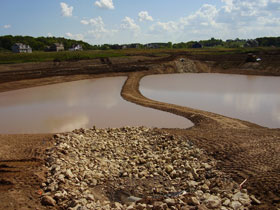
Dancing Waters Subdivision
Woodbury, MN
Eight + acres, July 2006
The lake in the Dancing Waters Community was built by Seepage Control, Inc. working with the Laurent Development Group, LLC. This development is comprised of 450 acres to the east of Minneapolis/St. Paul, MN.
Before involving Seepage Control, Inc. in the project, a substantial sinkhole developed during the initial construction of the lake bottom. Our company was called in to evaluate the damage and subsequent reconstruction of the lake bottom. Using our Treated and Compacted method we constructed a 24” ESS-13 compacted clay liner on the bottom and the area over the sink hole. The rest of the pond was built with a 12” ESS-13 compacted clay liner. The lake was filled and is holding great.
This project is a great example of combining the benefits of ESS-13 with the expertise of our On-site field representatives to create a successful project.
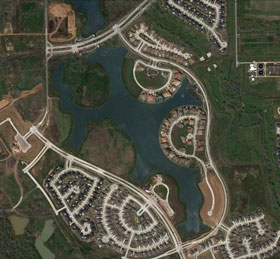
Riverstone Development
Sugarland, TX
76 acres
The Riverstone Development master-planned community near Sugarland, Texas encompasses over 3,700 acres. One of the focal points of this subdivision is a beautiful 76-acre, man-made lake.
The engineer’s specification for the lake lining was 2’ of 25 pi soil. Unfortunately, the on-site soil would not meet this standard and the developer was faced with importing the necessary clay – a very expensive proposition.
The decision was made to utilize ESS-13, as manufactured by Seepage Control, Inc. Not only was the contractor able to use the on-site soil, but because of the incorporation of ESS-13, approval was given to create the lining system with just 12” of soil. ESS-13 was incorporated into soils ranging from 15 to 25 pi. The savings in construction costs alone more than paid for the cost of the ESS-13.
Prior to the construction of the lake, the whole region had been experiencing drought conditions for several years. In the early stages of construction, however, the area experienced its wettest season in recent history. Although the wet weather caused construction delays, there was no damage to the previously placed soil lining system from the storms.
In addition to overseeing the installation of the ESS-13 Treated and Compacted lining system, Seepage Control’s on-site representatives were able to assist with and make recommendations for repairing a number of structural flaws that had developed prior to Seepage Control being on-site.
There were many advantages in using ESS-13 such as: a substantial savings in construction time over having to import 2’ of off-site clay; the experience and expertise of the on-site representatives; the flexibility of the system to accommodate the unpredictable weather; as well as the warranty provided by Seepage Control, Inc.
This area is steadily growing and the Riverstone lake should continue to be a very beautiful attraction to the area for many years to come.
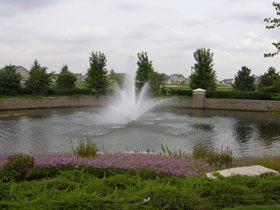
Easton Park Project
Plano, IL
110,000 sq ft
Easton Park is a housing development in Plano, IL by Lakewood Homes that included a beautiful man-made lake that did not hold water.After the soil was evaluated, Seepage Control, Inc. was consulted and recommended a Waterborne Application of ESS-13 to bring the lake into compliance. The treatment was completely successful.
Golf Courses
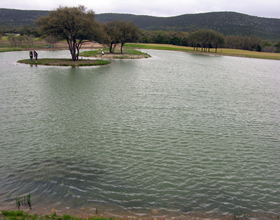
Concan Country Club
Concan, TX March 2006, (6 acres)
In February, 2006 Seepage Control, Inc. was contracted to seal the six-acre lake at Concan Country Club at Mountain Valley.
A combination of Treat and Compact and Spray-On applications was used due to the poor quality, talc-like, soil. We were told that “all the ponds in this region of Texas were dry due to the poor soils.”
The success of this project was critical as this pond would be the only source of water for irrigation of the golf course. Upon completion, the pond was filled and to this day holds perfectly. The pond is able to maintain all the irrigation needs of the course and also supports an abundant population of fish.
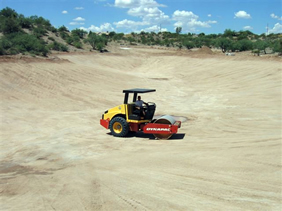
Wickenburg Golf Club
Wickenburg, AZ August 2006, (3.31 acres)
In August 2005 Terry Woodland with Woodland Golf International hired Seepage Control to repair a few lakes totaling about 3.31 acres at the Wickenburg Golf Club. The Spray-On treatment was used on this project.
The soils in this area were very sandy and terrible for lake sealing. In this situation extra time was spent moisturizing and rolling over the soil preparing the sub-grade. Once the sub-grade was smooth rolled, the ESS-13 Spray-On was applied in several coats. After allowing the product to sit for a short time, the lakes were filled.
Currently the lakes are holding well. Wickenburg Golf Club was successful at repairing their lakes using their native soil and reduced their potential repair costs substantially.
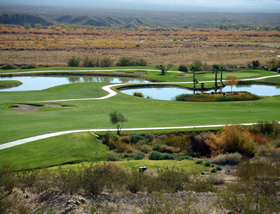
Palms Golf Course
Mesquite, Nevada July 1988, 8 lakes (26.5 acres)
Originally referred to as the Peppermill Golf Course in Mesquite, NV, this project involved the new construction of eight lakes of various sizes for a new golf course and casino. This project proved to be foundational to the growth of Mesquite, helping grow the town from approximately 1,000 residents in 1980 to an estimated population in July 2005 of 13,523.
The Seepage Control on-site representative was able to help locate usable soil in the area. This soil, in conjunction with ESS-13 and the native soil, was used to build a 12” high density soil liner. The eight lakes were constructed over a period of about two and half months. Upon completion all were holding tight, and are still sealed and in use today.
Stone Ridge Golf Club
Maplewood, MN July 2001, (approximately 1 acre)
The Stone Ridge lake was a challenging project. This was due to wet conditions as well as a significant amount of sand located in the deeper ends of the lake. Some creative installation procedures were required. These included pushing the wetter soil from the bottom up onto the sides. In addition, a high concentration of ESS-13 was sprayed onto the sandier areas. The high moisture content of the soil caused significant pumping, making compaction less than ideal. However, the unique ability of ESS-13 to seal soil in a saturated environment offsets these adverse conditions. The product and these techniques allowed for the completion of the liner in just three days. The end result was a sealed lake that is holding well today.
This project is an example of the successful use of ESS-13 in a challenging environment.
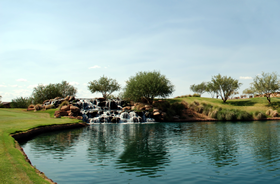
Anthem by Del Webb
Anthem, AZ April 2003, (7.5 acres soil surface)
Anthem is a planned suburb developed by Del Webb as a new kind of entire community development. It is located about 34 miles north of Phoenix, AZ. The initial construction was completed in 1998 and the population in the community has grown to over 40,000 people.
This golf course is located on the north side of Anthem. It is a 36-hole championship course designed by Greg Nash. The entire complex is beautifully designed. The facility contains several lakes and various water features.
Seepage Control, Inc. was contracted by Desert Reflections to build the lakes. Using the Treated and Compacted method we constructed the liners for approximately 326,700 sq ft of soil surface area. The lakes are doing well, and are probably some of the most beautiful lakes we have been involved in.
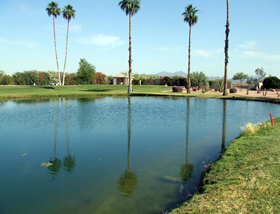
Apache Wells Golf Club
Mesa, AZ April 2007 (1.75 acres)
This 1.75 acre pond had been losing 1 ½ inches of water per day for an extended period of time. The golf course had not been able to keep up with the water loss along with their irrigation needs. The Apache Wells Golf Course elected to have Seepage Control, Inc. seal their pond using the ESS-13 Waterborne method.
This golf course is 25 years old, and the pond was stocked with fish – some of them original. No fish were lost during the treatment process, and after the treatment, the client was pleased to report no measurable water loss.
Ski Lakes
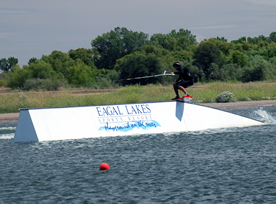
John Eagal Competition Ski Lake
Stockton, CA March 2006
In December 2001, John Eagal contacted Seepage Control to assist him in building a 20 acre competition ski lake on the banks of the San Joaquin River, in Tracy, CA. The native soil was extremely sandy. Seepage Control worked with John over the next five years during the permitting process to determine the best way to seal his lake.
In December 2006 work began to actually seal the lake. Our field department made several trips to the site to supervise the construction of the lake’s sub grade. Large areas of pure sand had to be removed and replaced with more suitable soil. This process of preparing the lake took several months. Once prepared, our field operations team was on-site to supervise every step of the sealing process. Along the way, design changes challenged our field department and allowed us to show the flexibility of our product and application techniques.
On February 7, 2007 the pump was charged and water began to fill the lake. On March 5th, 2007 the lakes were full and ready for water loss testing. A seven day loss test indicated that the lake was losing a total of 3/4” per day. This daily loss measurement was determined to be 100% evaporation. Subsequent inspections of the lake over the past several months have confirmed zero suspected loss due to seepage.
Ninovan Lake Estates
Minooka, IL July 2002, (23 acres)
This ski lake was certainly not the ideal project. There were significant challenges in bringing the lake to a usable state. The initial construction of the lake was fairly uneventful, however the water to fill the lake was to come from watershed run off. This water never materialized and after 2 years the lake had very little water and had experienced significant erosion and vegetation over-growth. At this point wells were installed and the erosion above the water line was repaired using our Treated and Compacted method. Our waterborne treatment was used to repair any submerged areas. Now the lake is full, in use, and is a central part of this beautiful neighborhood.
Wastewater

Cimarron Sewage Lagoon, City of Cimarron
Cimarron, Kansas Winter of 1998
Two lagoons (15 acres) empty, One lagoon (5 acres) full
Seepage Control, Inc. was contacted for this lagoon project when bentonite clay mixed with the native soil failed to meet the required permeability rate. The small cell was tested with fresh water after bentonite was added to the soil. When the results did not meet specifications, Seepage Control, Inc. was hired to add ESS-13 directly to the water under a fresh layer of ice! After three weeks the lagoon was refilled with fresh water and the results exceeded permeability requirements. At that time, the lagoon was put in use.
The two larger lagoons used ESS-13 mixed with the soil to create a 12 inch treated and compacted soil barrier. The ESS-13 was sprayed on the soil using a water truck. Because of the large, flat surface the mixing disc was able to follow the water truck through the whole lagoon. The compactor was able to follow the disc as well. This efficient operation yielded an average of over three acres per day sealed -- start to finish. In addition, no cover was needed to protect the seal. This resulted in a substantial savings compared to a plastic liner. When the lagoons were filled, the testing showed this. ESS-13 application greatly exceeded the requirements for a sealed sewage lagoon.

Lone Butte Waste Water Treatment Plant
Sewage Lagoon
Chandler, AZ
The Lone Butte WWTP is located in Chandler AZ, and operated by the City of Glendale, AZ. In 2001, work was done to improve structures on site. The upper slopes of the lagoon needed to be rebuilt. Seepage Control, Inc. was contracted to fix exfiltration losses in excess of ¼” per day at a 10 foot water depth. Soil testing revealed the available material on site to be of a clayey sand composition.ESS-13 was applied in a Treated and Compacted method using two 6” lifts over a 50,000 cubic foot area.
This project is a successful example of using ESS-13 for post-construction repairs.
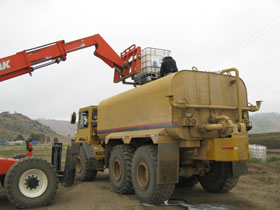
Tehachapi Sewage Lagoon
Tehachapi, CA
26 acres
We recently completed the first three cells (totaling 18.8 acres) at the Tehachapi State Prison Waste Water Treatment Plant. This project entails more than 26 total surface acres to be sealed. Seepage Control was actively involved with the engineer during the specification process, we attended the pre-bid and pre-construction meetings, and we have been intrinsically involved in the installation process. We have had a representative on-site when our products have been used and worked closely with the contractor to ensure the complete success of this project.
Utilizing our ESS-13 Treated and Compacted and ESS-13 Spray-On Applications, we have been able to surpass California State’s stringent environmental standards while utilizing the on-site soil.
Wetlands
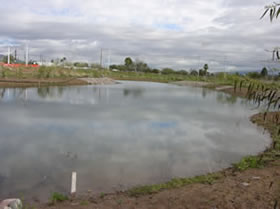
Rio Salado Environmental Restoration
City of Tempe
Tempe, AZ
The Rio Salado project is located just Northeast of Tempe Town Lake in Tempe, AZ. This was a wetland project overseen by the US Army Corps of Engineers. Seepage Control, Inc. partnered with Macro-Z-Technologies of Santa Ana, CA to develop an environmental, aesthetic watershed solution.
The wetland covers approximately 140,000 sq.ft., is almost 8 ft deep, and holds about a million gallons of water. The native soil was determined to be sandy clay with trace gravel. Seepage Control, Inc. recommended a Treat and Compact method combined with a Spray-on treatment because of the nature of the soil. Lab tests showed a hydraulic conductivity of 3.5 x 10-6 cm/s from the Treat and Compact only. After combining this with a Spray-on treatment the hydraulic conductivity was reduced to 5.9x10-7 cm/s.
This project is a successful example of using less than acceptable soil to create a beautiful sealed wetland.
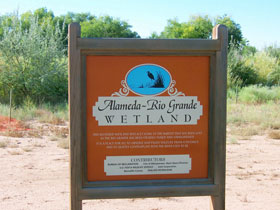
Alameda Wetlands
City of Albuquerque
Albuquerque, New Mexico
This was a cooperative project between the Bureau of Reclamation, the City of Albuquerque - Open Space Division, the US Fish & Wildlife, Intel Corporation, Bernalillo County, and Philips Petroleum.
The wetland covers 139,392 sq ft (3.2 acres) and was constructed with the intention to replicate the natural wetlands that historically occupied the floodplain of the Rio Grande.
Fisheries

Byron State Fish Hatchery
Byron, OK
The 4.5 acre pond was located next to a river, in an existing gravel pit. On site soil was mixed with ESS-13 and used to construct the liner. Due to the proximity to the river, and the porous nature of the gravel sub grade, groundwater was flowing up into the proposed pond area causing compaction efforts to fail. Seepage Control developed an innovative de-watering system from within the pond which allowed compaction of the soil liner to be possible. This was followed up with a Seepage Control designed "rapid fill" over the de-watering area to prevent the groundwater pressure from causing a blow out of the soil liner.
Byron Hatchery Watchable Wildlife Area (WWA) is a destination on the Great Plains Trail and showcases three different habitats in a 40-acre area. Byron WWA includes a 1/2-mile self-guided trail through a cat-tail marsh, forested swamp and restored mid-grass prairie. The trail contains informational signs, observation blinds and piers to get visitors closer to wildlife. Other features designed to attract wildlife include bat houses, chimney swift tower, a barn owl nest house and a bluebird trail.
Located adjacent to the Byron state fish hatchery that provides sportsfish such as saugeye, walleye, striped bass hybrids and smallmouth bass for statewide stocking, Byron WWA has an ever-changing variety of wildlife and blooming plants. Schools and citizens are encouraged to visit both sites to see what’s new. The WWA is open for self-guided tours daily during sunlight hours; weekday visitors also can tour the fish hatchery from 9 a.m.-4 p.m.
Directions to Byron Hatchery: Byron Hatchery is located north of Great Salt Plains Refuge. From the junction of Highways 38 and 11, go north two miles and turn west at the first intersection.

Colorado Fisheries, Inc.
or more recently known as Global Fisheries Management
Ft. Collins, CO
Seepage Control, Inc. has partnered with CFI on several projects. As professionals in fisheries management they are well known in the industry for not only their consulting, and stocking, but also the restoration of streams, lakes and ponds. Located in Ft. Collins, CO, they have been involved in a variety of projects mainly in Colorado, but as far as away as Hawaii.
City Parks
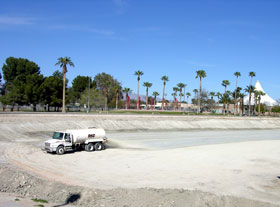
Reid Park
City of Tucson
Tucson, AZ
In October of 2004, the City of Tucson contracted with Seepage Control, Inc. to repair their 2.5 acre lake at Reid Park. Prior to the lake renovation, the lake was losing 200,000 gallons per 24 hour period.
Initially the project was to be a simple treat and compact application. After the preliminary site investigation it became apparent that the soil quality was less than optimal. In addition, there were several pipe penetrations (many of which were part of the original construction). It was decided to switch to a Spray-on technique and spend more time on repairing the aging pipes. This project was an excellent example of a complete pond renovation.
The water loss attributable to seepage after the lake renovation was 300 gallons of water per day - a reduction of 99.85%.
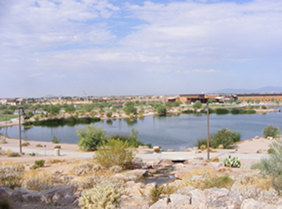
Oasis Recharge Park
Chandler, Arizona
6.2 acres
The vision of the Veteran's Oasis Recharge Park was to create an urban fishing lake to serve the expanding community of Chandler, Arizona. Due to the poor soil quality, a lake lining system was needed in order to maintain the water level in Arizona's dry and arid conditions. The requirement established by the city engineers for the lake was a seepage rate of no more than .1% of the lake volume per day.
The construction was completed by the Seepage Control Construction Division and was expected to be a complete success. When the lake was filled, however, the initial results were disappointing at best. Loss measurements taken revealed that the six-acre lake was losing more than 2" per day, resulting in a loss of more than 325,000 gallons of water a day.
When the lake was drained, our field representative was able to identify the problem. Prior to lining the lake, the City had hired a pipe contractor to install a pipe under the subgrade. In one 20-foot section of the slope, the pipe trench had literally caved in. This left a significant crack running the length of the trench which allowed the water to freely flow through the trench and out of the lake.
This area was repaired under the supervision of our on-site field representative and the lake was refilled. We are pleased to report that new loss measurements showed that the results well exceed the standards required. This lake is now the focal point for this beautiful park that functions as an educational, family-friendly oasis in the desert.
For more information, or to tell us about your project, please contact us today!
